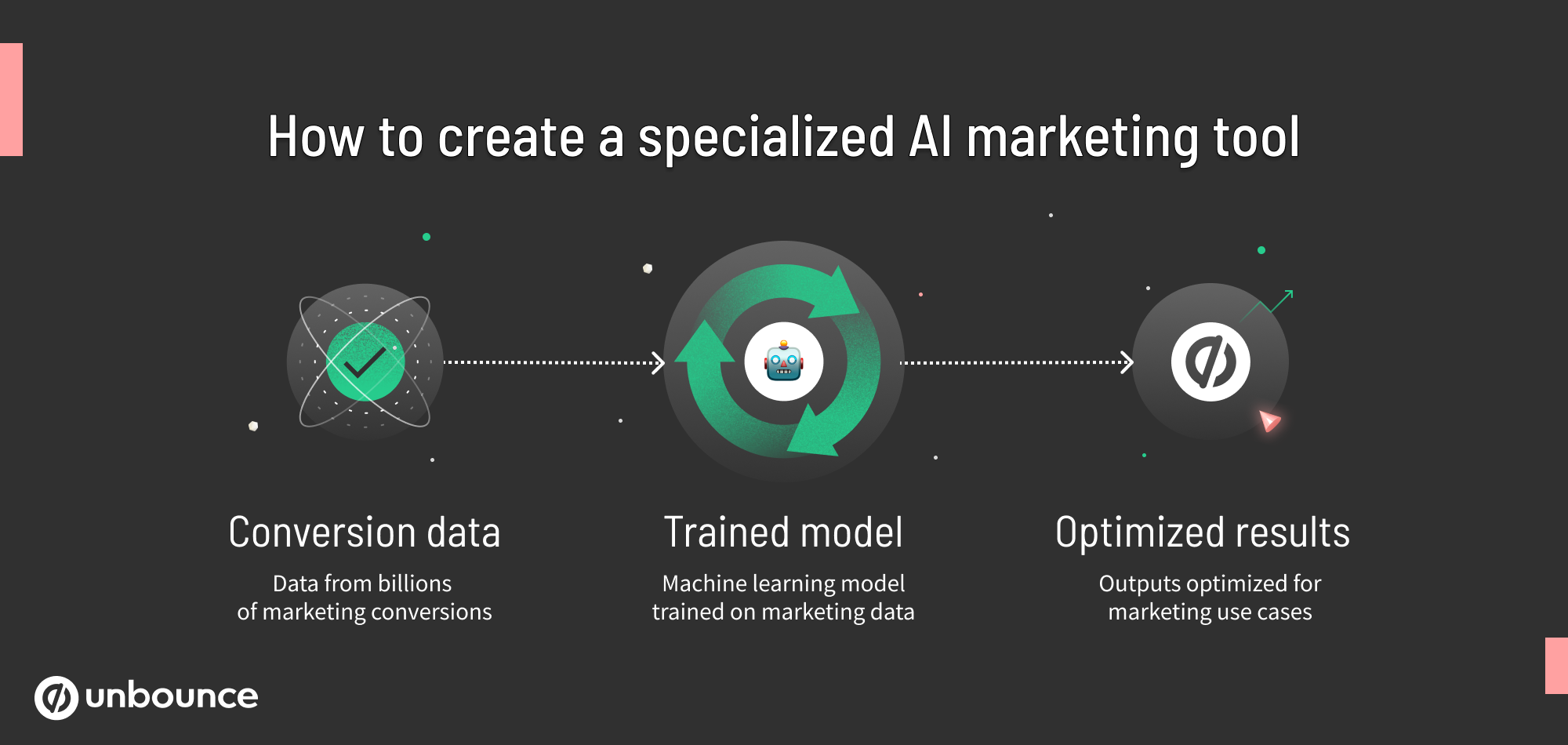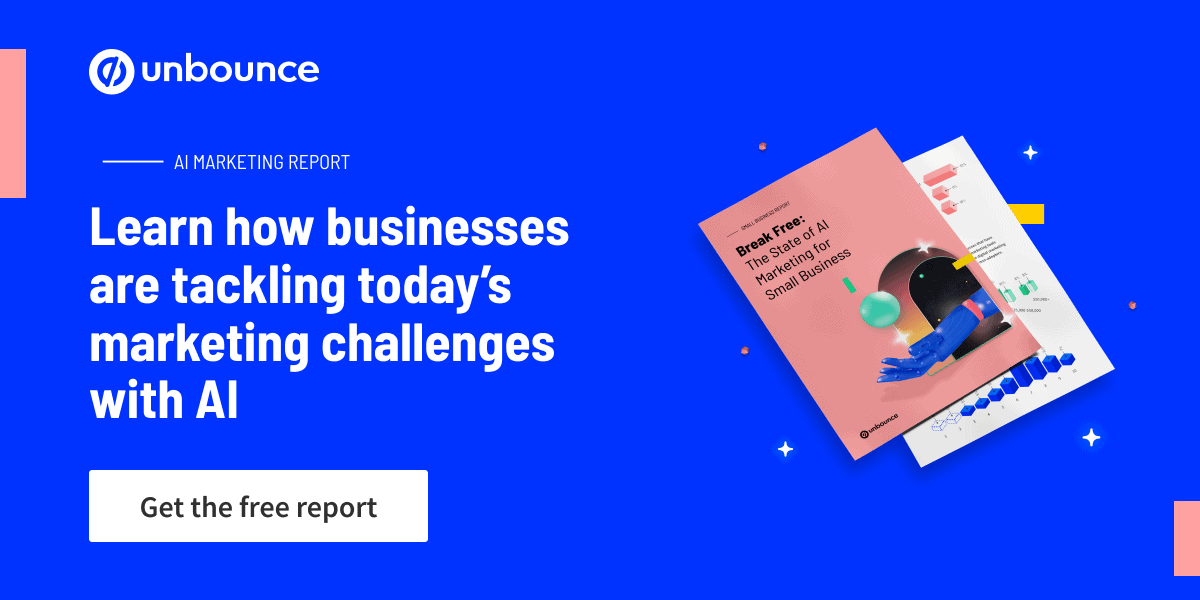[ad_1]
Artificial intelligence has come a long way in a (very) short space of time. Just a few months ago, many of us were scoffing—and some, admittedly, were guffawing—at the idea that AI could perform tasks at the quality of (and sometimes better than) a squishy human brain.
Oh, how naive we were.
AI has arrived, and now it’s friggin’ everywhere. Ryan Reynolds is writing ads with ChatGPT for Mint Mobile. John Oliver is talkin’ about AI-generated images in Midjourney. And marketers are quickly discovering how these AI-powered tools can help ‘em spin up entertaining blog content, optimize their social ad campaigns, and analyze their email performance.
But not all AI is created equal. (Or, maybe, some AI is created too equal.) Many of the AI tools available to marketers right now are built using the same generic models—models that weren’t built specifically for marketing use cases. That means their outputs tend to be kinda… same-y. And these tools aren’t optimized to get marketers the best performance from their campaigns.
Mike Kaput (Chief Content Officer at the Marketing AI Institute) and Jess Petrella (Director of Product Marketing at Unbounce) recently talked about the explosion of AI marketing tools and how to evaluate different AI solutions.
Because—as they discuss—not every AI tool is a good fit for marketers.
Hold up—where did all this AI stuff come from?
Real quick, let’s bring everybody up to speed on AI marketing.
A few years ago, true artificial intelligence felt like a sci-fi fantasy—but behind closed doors, some of the biggest tech companies have been pouring resources into AI development. Search giants like Microsoft and Google have been particularly interested in generative AI, which is AI capable of creating text or images. For example, in 2019, Microsoft dumped a $1 billion investment into OpenAI, an AI research and development lab. Not long after, OpenAI launched GPT-3, a language model capable of generating human-like text responses to prompts.
GPT-3 was also made available to other developers via API, meaning other software could (and did) incorporate the tech. Quietly, this was the beginning of a generative AI boom.

We have big businesses like Google and Microsoft putting a lot of money into AI and [adding it to] the regular workflow of their products—products that organizations, individuals, and end users are (by the millions) leveraging every day.
It’s still very early days, but these are signals that [AI] is something that is here to truly and long-term augment […] how we work.
GPT-3 made some waves—but marketers mostly kept on keepin’ on. Then came a pandemic, which brought economic uncertainty: the Great Resignation, the crypto and NFT booms (and busts), and endless talk of recession. The last few years have been weird, to say the least—and amidst it all, marketers have continuously been asked to do more with less.
In 2022, we surveyed 400 businesses to find out if (and how) they’re adopting marketing AI. Nearly half said they didn’t have the budget to do effective marketing, while a third reported they didn’t have the time. And companies were taking steps to address those problems: 31% had already adopted AI marketing tools and another 63% were interested in AI.
We were hitting a tipping point. Maybe some folks noticed it earlier than others—but by the time ChatGPT launched in late 2022, it became clear to everyone that marketing was about to change dramatically.

ChatGPT (built on top of the improved GPT-3.5, then GPT-4) gave us a new, simpler way to work with AI. Ask it a question, it’ll answer. Give it a task, it’ll do its darnedest. ChatGPT was the “aha!” moment in our collective consciousness—followed quickly by a collective “oh, $%!#.”
Suddenly, AI is all marketers can talk about. Google and Microsoft are locked in an (increasingly public) arms race to deploy this new technology, which could totally transform how people find and engage with content online. Many of the tools marketers have been using for years—like Grammarly, Adobe, or, hello, Unbounce—are now augmented with AI, streamlining workflows and optimizing results. Whether you know it or not, you’ve probably used AI sometime in the past week.
And that’s a good thing—at least, for the marketers who are starting to integrate AI into their process.

A marketer not using AI just can’t compete. We like to say at the [Marketing AI Institute]: AI isn’t going to replace you, but a marketer using AI will probably replace marketers who don’t.
AI marketing is here. It’s happening. But this explosion of AI tools has left lots of us feelin’ dizzy. What’s legit? What’s hype? How do you choose between one AI marketing tool and the next?
AI is kinda like a car engine—if most cars had the same one
Imagine a car. Maybe you’re thinking of a Honda Civic. Maybe you’re thinking of a Ford Mustang. Heck, maybe you’re thinking of a Hummer. (Which probably says something about you, from a psychological perspective.)
What makes ’em different? They all have four doors (or close enough). They all run on gasoline and take you from one place to another. What makes people drool over one and laugh at another?
It’s all about what’s under the hood: the engine. (It’s why we’re getting a tenth Fast and Furious movie.) A sports car that can go from zero to sixty in ten seconds is waaaaay cooler than some low-horsepower sedan. But throw in a powerful engine (and a kick-butt spoiler), and suddenly you’re Vin Deisel.

But unlike cars, most AI marketing tools have the exact same engine. Jess explains:

The underlying technology is quite similar in a lot of the tools that [marketers are] leveraging, but what makes certain tools for marketers different—and, at times […] more valuable—is the data sets that are on top of it, [which are] training that base machine learning model.
AI tools are often just user experiences built on top of machine learning models, like car frames built over engines. Those “engines” are, effectively, the AI doing the work of processing inputs and generating outputs. But while most engines are stock, some are souped up—trained on additional data to refine their outputs for certain use cases.
The stock engine works fine. But it’s not specialized to excel at a specific task. And the same concept applies to AI tools.
Like human marketers, AI can be a generalist or a specialist
Let’s take AI writing as an example.
When you use a platform like ChatGPT, you’re utilizing OpenAI’s GPT model. GPT was trained on the whole internet (with billions and billions of data points), but it’s not trained specifically to produce highly persuasive content for marketing use cases. Think of it as a marketing generalist—somebody who’s really good at lots of stuff but not necessarily specialized for a particular task or outcome.
Many of the most popular AI writing tools (say Jasper or Copy.ai) are also built on top of OpenAI’s generic GPT model—which means they’re also not producing content optimized for marketers.

Artificial intelligence is a bunch of models that need data. So, at the end of the day, the data you train it on determines your outputs. How you train it also matters dramatically.
A bunch of other companies are essentially just providing an interesting user experience that uses the same model that ChatGPT uses.
Compare that with an AI copywriting tool like Anyword, which is built specifically for marketers to create marketing copy using millions of marketing data points to score and predict your marketing performance. Or (shameless plug) Unbounce, which provides AI-powered insights based on our own conversion data to make recommendations as you write.

The benefits of using an AI writing tool trained specifically for marketing should be obvious. You get more refined outputs on your first pass, so spend less time wrestling with prompts. You get content that data shows is proven to be impactful for your audience. You save time and get more conversions.

Proprietary, unique, and extensive data is going to be the only competitive advantage moving forward, because if you’re doing anything related to language, the dataset already exists. OpenAI is using it.
Of course, this “generic AI” versus “specialized AI” divide doesn’t only exist in AI copywriting tools. Because OpenAI has made GPT and DALL-E (its image generation model) available to other companies, generative AI is the space where it’s most common to see companies utilizing the same generic models. But as new models become available for different use cases, marketers need to consider whether an AI tool is specialized for marketing—or if it’s outputs are more generic.
How to find and evaluate specialized AI marketing tools
Choosing the right AI tools for your marketing stack can seem daunting, given the huge (and ever-increasing) number of options available. We’ve seen how much the AI landscape can change, even in just a few months. How do you know which tools are best for your marketing use case? How do you make the best choice for your team and your business?
It’s all about asking the right questions. As Jess and Mike point out, there are a few important considerations:
1. Where’s the data coming from?
Figure out if the data used to train the AI tool is homegrown or gathered from elsewhere. Knowing where the data came from (and whether it’s of good quality) will help you decide whether the tool is a good fit for your needs. Plus, it’ll help you evaluate whether you can trust the information you’re getting back.

If you’re a marketer, where the data came from to train the tools that you’re using is truly important. Because unless [they] have millions or billions of proprietary data points, you’re probably looking at [a tool] that is using data that one of the bigger players already has.
For instance, Unbounce’s Smart Traffic uses AI to optimize landing pages based on years (and years, and years) of collecting data from landing pages that convert—or don’t. It’s data that no other company could ever possibly replicate (we dare you to try), giving users a distinct advantage over AI conversion optimization tools that are just getting started.
2. How accurate is the model?
Dig into whether the platform produces accurate, impactful results. Like people, machines are molded by the information they’ve processed and internalized—which is not always correct. It’s essential to be aware of any inherent biases or flaws in the AI tool as they could negatively impact your marketing efforts.

We’ve seen a hundred different stories already of outputs from ChatGPT that sound really confident, but are totally wrong, or reinforce problematic approaches or biases to certain pieces of information.
The goal here is to reduce your work, not make more of it—so be sure you’re not gonna have to double-check everything the machine is doing.
3. Is this realistic? (Or even a good thing?)
Lots of the hype around AI is the idea that it might soon replace human marketers. And while AI certainly is developing at breakneck speed, it’s important to maintain a realistic perspective on its current capabilities. Yeah, it can streamline many aspects of your marketing workflow—but it’s no replacement for things like human creativity and empathy.

AI is a supporting tool to the marketing that you’re already doing, right? It can write a blog post for your from beginning to end, it can write your ad copy. But without the human assessment of those outputs […] it’s not as valuable.
Be wary of companies who promise to singlehandedly revolutionize your marketing strategy and put your marketing team outta work. It’s crucial to work with tools that acknowledge the balance between human expertise and AI-driven optimization.
Specialized AI marketing tools amplify you—the marketer
Yes, AI has made rapid advances in the past few years (ahem, months), and its impact on the way we work as marketers is undeniable. But not all AI tools are the same. The key to making the most of this new technology is recognizing the difference between generic and specialized AI—and knowing when you oughta use which. By asking the right questions and being realistic about its capabilities, you can confidently integrate AI into your marketing stack and use it to its full potential.

There’s no competitive advantage to [creating] generic content—at least in the example of content marketing—with these AI tools. It’s augmenting rockstar writers and content creators with these tools to help them be 10x more productive, 10x more impactful.
But even specialized AI is no replacement for people. (Not until it can hug us, anyway.) The most Marketing™️ of marketing tools are still most impactful when they’re in the hands of talented, imaginative humans. By working hand-in-algorithm with AI, you can streamline your campaign workflow, get more leads and sales, and push the boundaries of what you thought was possible.
[ad_2]
Source link










